|
My United States Paper Money Collection |
|
One Dollar | Two Dollar | Five Dollar | Ten Dollar | Twenty Dollar | Fifty Dollar | Hundred Dollar | Miscellaneous
|
Ten Dollar Bills |
|
Series 1901 Ten Dollar United States Note ("Bison")

 
The Series 1901 Twn Dollar United States Note was issued in the large size of 7-3/8 by 3-1/8 inches (about 50 percent larger than today’s paper currency) and features a striking portrait of an American bison on the obverse, flanked by smaller portraits of the famous explorers Lewis and Clark. The entire design of the note reflects a time in American history when currency was not just money but also a work of art. Also on the obverse are the phrases, "UNITED STATES NOTE", "THE UNITED STATES OF AMERICA WILL PAY TO THE BEARER TEN DOLLARS", "THIS NOTE IS LEGAL TENDER FOR TEN DOLLARS SUBJECT TO THE PROVISIONS OF SECTION 3588 R.S." and "AUTHORIZED BY THE LEGAL TENDER ACTS OF 1862 AND 1863."
The reverse depicts a classical depiction of the metaphorical Columbia walking between two pillars presenting America's fruits of labor to the rest of the world (symbolized by the sheaf of wheat she is holding over her head) and the text, "THIS NOTE IS A LEGAL TENDER AT ITS FACE VALUE FOR ALL DEBTS PUBLIC AND PRIVATE EXCEPT DUTIES ON IMPORTS AND INTEREST ON THE PUBLIC DEBT."
|
Series 1902 Ten Dollar National Bank Note (Red Seal)
(New York, New York)

 
The Act of April 12, 1902 allowed existing National Banks to receive a 20 year extension under the original National Banking Act of 1863, and also called for a new series of note designs to be issued. Over the next 28 years, there were 3 distinct types of Series 1902 bank notes issued: 1902 Red Seal, 1902 Date Back and 1902 Plain Back (which had the same design as the Date Back, except that the dates were no longer shown on the back). Red Seals are the rarest type with only 5% of the total Series 1902 notes reported. Note that the obverse includes two separate serial numbers: a bank serial number in the lower left corner and a Treasury serial number in the upper right corner.
This particular note was issued by The Hanover National Bank of the Ciry of New York, New York, with a charter date of June 17, 1905. The obverse features a portrait of President William McKinley and the words "NATIONAL CURRENCY SECURED BY UNITED STATES BONDS DEPOSTED WITH THE TREASURER OF THE UNITED STATES OF AMERICA", "SERIES OF 1902", "THE HANOVER NATIONAL BANK OF THE CITY OF NEW YORK WILL PAY TO THE BEARER ON DEMAND TEN DOLLARS" and New York, NEW YORK June 17, 1905."
The reverse features an engraving of the classic vignette "Liberty and Progress" and the words, "NATIONAL CURRENCY" and "THIS NOTE IS RECEIVABLE AT PAR IN ALL PARTS OF THE UNITED STATES IN PAYMENT FOR ALL TAXES AND EXCISES AND ALL OTHER DUES TO THE UNITED STATES EXCEPT DUTIES ON IMPORTS AND ALSO FOR ALL SALARIES AND OTHER DEBTS AND DEMANDS OWING BY THE UNITED STATES TO INDIVIDUALS CORPORATIONS AND ASSOCIATIONS WITHIN THE UNITED STATES EXCEPT INTEREST OF PUBLIC DEBT."
|
Series 1902 Ten Dollar National Bank Note ("Plain Back" Blue Seal)
(Cuba, New York)

 
The Act of April 12, 1902 allowed existing National Banks to receive a 20 year extension under the original National Banking Act of 1863, and also called for a new series of note designs to be issued. Over the next 28 years, there were 3 distinct types of Series 1902 bank notes issued: 1902 Red Seal, 1902 Date Back and 1902 Plain Back (which had the same design as the Date Back, except that the dates were no longer shown on the back). Plain Backs are the most common type and were issued from 1915 through 1929. Note that until August 23, 1925, the obverse included two separate serial numbers: a bank serial number in the lower left corner and a Treasury serial number in the upper right corner. After August 23, 1925, the Treasury serial number was removed and replaced with a duplicate of the bank serial number, which means that this particular note was printed after that date.
This particular note was issued by The Cuba National Bank of Cuba, New York, with a charter date of April 25, 1905. The obverse features a portrait of President William McKinley and the words "NATIONAL CURRENCY SECURED BY UNITED STATES BONDS DEPOSTED WITH THE TREASURER OF THE UNITED STATES OF AMERICA", "SERIES OF 1902", "THE CUBA NATIONAL BANK WILL PAY TO THE BEARER ON DEMAND TEN DOLLARS" and "Cuba, NEW YORK, Apr 25, 1905."
The reverse features an engraving of the classic vignette "Liberty and Progress" and the words, "NATIONAL CURRENCY" and "THIS NOTE IS RECEIVABLE AT PAR IN ALL PARTS OF THE UNITED STATES IN PAYMENT FOR ALL TAXES AND EXCISES AND ALL OTHER DUES TO THE UNITED STATES EXCEPT DUTIES ON IMPORTS AND ALSO FOR ALL SALARIES AND OTHER DEBTS AND DEMANDS OWING BY THE UNITED STATES TO INDIVIDUALS CORPORATIONS AND ASSOCIATIONS WITHIN THE UNITED STATES EXCEPT INTEREST OF PUBLIC DEBT.
|
|
Series 1907 Ten Dollar Gold Certificate

 
Once redeemable for gold on demand, these scarce notes are America's only large-size $10 Gold Certificates. Depicting the first U.S. treasurer Michael Hillegas, they were produced from 1907 to 1922, and then replaced by small-size notes. As a reminder that this note was redeemable for gold, the back is a bright orange-gold color. The Gold Reserve Act of 1933 made these illegal to own, but the restrictions were lifted in 1964, making them possible to own once again.
The obverse of this note reads, "THIS CERTIFIES THAT THERE HAVE BEEN DESPOSITED IN THE TREASURY OF THE UNITED STATES OF AMERICA TEN DOLLARS IN GOLD COIN PAYABLE TO THE BEARER ON DEMAND" and also bears the text, "ACT OF MARCH 4, 1907."
The reverse simply states, "GOLD CERTIFICATE" and "THE UNITED STATES OF AMERICA TEN DOLLARS."
|
|
Series 1914 Ten Dollar Federal Reserve Note (Red Seal)

  
Large Size Federal Reserve Notes were printed from 1878 to 1923 in the United States as part of its circulation of paper currency and were initially redeemable in the same face value of silver dollar coins, and later in raw silver bullion. Issued in the large size of 7-3/8 by 3-1/8 inches (about 50 percent larger than today’s paper currency), the design of the Series 1914 $10 Federal Reserve Note reflects a time in American history when currency was not just money but also a work of art. The obverse features an engraved portrait of President Andrew Jackson. The first of these Series 1914 notes had distinctive red Treasury seals at the right (later notes in the same Series had blue seals, as described below) as well as a black seal on the left bearing both the district number (1-12) and the district letter (A-L) of the Federal Reserve Bank of issuance. This regional seal is a design facet unique to Federal Reserve Notes, because almost all other types of notes were issued directly by the U.S. Treasury. The obverse also bears the phrases, "FEDERAL RESERVE NOTE", "AUTHORIZED BY FEDERAL RESERVE ACT OF DECEMBER 23, 1913" and "THE UNITED STATES OF AMERICA WILL PAY TO THE BEARER ON DEMAND TEN DOLLARS."
Note that, while all Series 1914 $10 Federal Reserve Notes were printed in Washington DC, they were issued for all twelve Federal Reserve districts (Boston, New York, Philadelphia, Cleveland, Richmond, Atlanta, Chicago, St. Louis, Minneapolis, Kansas City, Dallas, and San Francisco). The black seal on this particular note indicates that it was issued for the Federal Reserve Bank of New York, New York..
The reverse features two vignettes titled Farming and Industry. The rather lengthy redemption clause on the Series 1914 $10 Federal Reserve Note, also located on the reverse, states, "THIS NOTE IS RECEIVABLE BY ALL NATIONAL AND MEMBER BANKS AND FEDERAL RESERVE BANKS AND FOR ALL TAXES, CUSTOMS AND OTHER PUBLIC DUES. IT IS REDEEMABLE IN GOLD ON DEMAND AT THE TREASURY DEPARTMENT OF THE UNITED STATES IN THE CITY OF WASHINGTON, DISTRICT OF COLUMBIA OR IN GOLD OR LAWFUL MONEY AT ANY FEDERAL RESERVE BANK."
|
|
Series 1914 Ten Dollar Federal Reserve Note (Blue Seal)
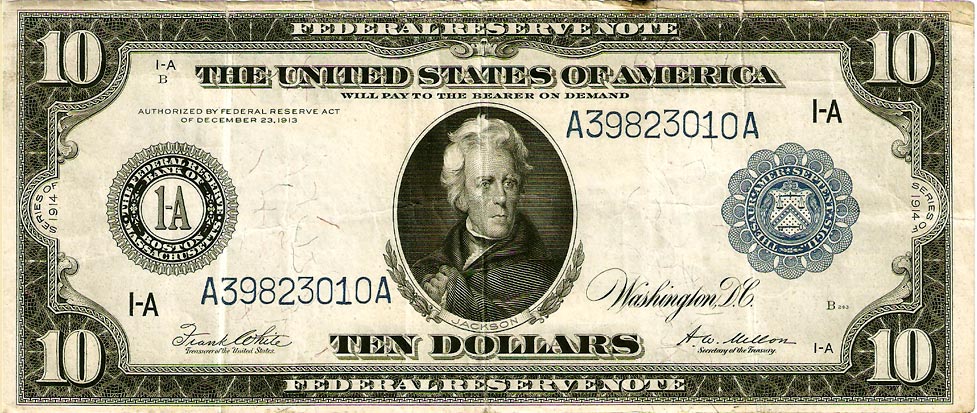
 
The Blue Seal Series 1914 Federal Reserve Notes are identical in design to the previously issued Red Seal versions (described above), except that the Treasury seal on the obverse is blue instead of red.
|
|
Series 1922 Ten Dollar Gold Certificate
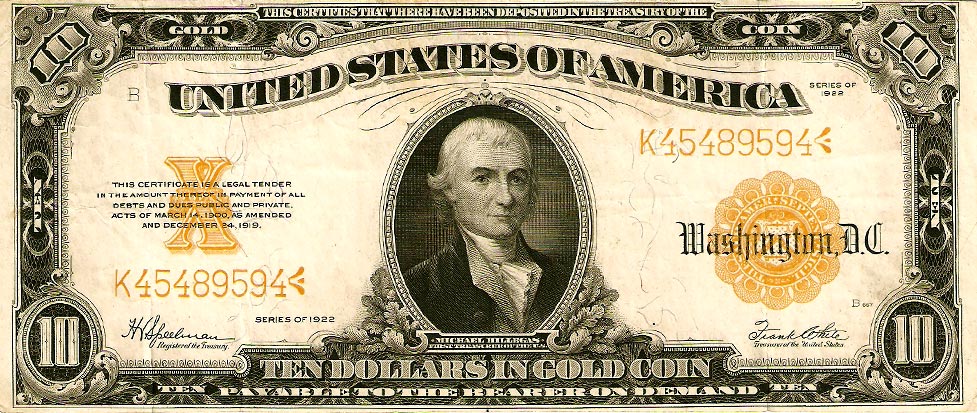
 
Once redeemable for gold on demand, these scarce notes are America's only large-size $10 Gold Certificates. Depicting the first U.S. treasurer Michael Hillegas, they were produced from 1907 to 1922, and then replaced by small-size notes. As a reminder that this note was redeemable for gold, the back is a bright orange-gold color. The Gold Reserve Act of 1933 made these illegal to own, but the restrictions were lifted in 1964, making them possible to own once again.
The design of the Series 1922 Ten Dollar Gold Certificate is very similar to that of the Series 1907 Ten Dollar Gold Certificate, the primary difference being the addition of a new obligation clause on the obverse stating, "THIS CERTIFICATE IS A LEGAL TENDER IN THE AMOUNT THEREOF IN PAYMENT OF ALL DEBTS AND DUES PUBLIC AND PRIVATE. ACTS OF MARCH 14, 1900, AS AMENDED AND DECEMBER 24, 1919" in addition to the existing redemption clause that states, "THIS CERTIFIES THAT THERE HAVE BEEN DESPOSITED IN THE TREASURY OF THE UNITED STATES OF AMERICA TEN DOLLARS IN GOLD COIN PAYABLE TO THE BEARER ON DEMAND."
The reverse simply states, "GOLD CERTIFICATE" and "THE UNITED STATES OF AMERICA TEN DOLLARS."
|
|
Series 1923 Ten Dollar Legal Tender Note ("Poker Chip")
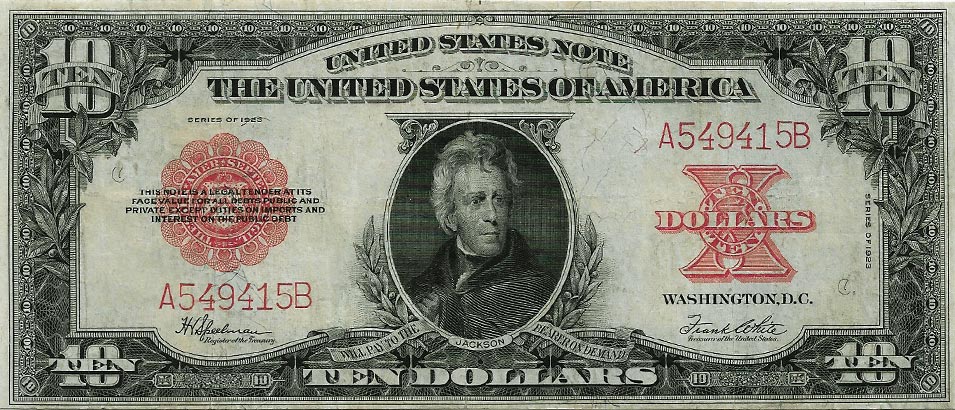
 
The Series 1923 $10 Legal Tender Note is one of the rarest and most valuable large size notes printed during the 20th century with only a total of 696,000 printed and only approximately 500 still known to exist in various conditions. In addition to so few bring printed and so few remaining, the Series 1923 $10 legal Tendser note was also a one year, one signature, unique type design. It is nicknamed the "Poker Chip" Note due to the design on the back that resembles a pair of poker chips. The obligation clause on the obverse reads, "THIS CERTIFICATE IS A LEGAL TENDER AT ITS FACE VALUE FOR ALL DEBTS PUBLIC AND PRIVATE EXCEPT DUTIES ON IMPORTS AND INTEREST ON THE PUBLIC DEBT." The obverse also states "UNITED STATES NOTE" and "THE UNITED STATES WILL PAY TO THE BEARER ON DEMAND TEN DOLLARS."
The green reverse features an image of the U.S. Treasury Building.
|
|
Series 1928 Ten Dollar Gold Certificate
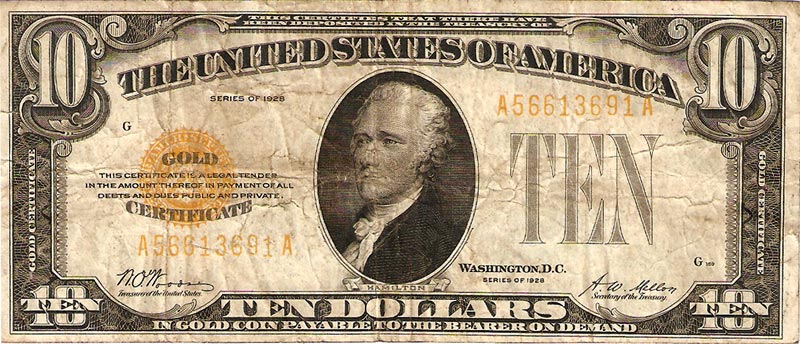
 
Once redeemable for gold on demand, U.S. Gold Certificates are among the most sought after of all paper currency. Previous $10 Gold Certificates were issued as large notes, but the Series 1928 is the first and only $10 Gold Certificate issued. Rendered obsolete by Franklin Roosevelt’s Gold Recall Order of 1933, these notes feature an engraved portrait of Alexander Hamilton and bear a distinctive gold Treasury seal and serial numbers. The obligation clause on the obverse reads, "THIS CERTIFICATE IS A LEGAL TENDER IN THE AMOUNT THEREOF IN PAYMENT OF ALL DEBTS AND DUES PUBLIC AND PRIVATE. ACTS OF MARCH 14, 1900, AS AMENDED AND DECEMBER 24, 1919." The redemption clause on the obverse states, "THIS CERTIFIES THAT THERE HAVE BEEN DESPOSITED IN THE TREASURY OF THE UNITED STATES OF AMERICA TEN DOLLARS IN GOLD COIN PAYABLE TO THE BEARER ON DEMAND."
The green reverse features an image of the U.S. Treasury Building.
|
|
Series 1928B Ten Dollar Federal Reserve Note

 
The Series 1928 $10 Federal Reserve Note was the first to feature a green Treasury Seal. These notes also carried a black seal on the left bearing the identity of the Federal Reserve Bank of issuance. The regional seal is a design facet unique to Federal Reserve Notes, because almost all other types of notes were issued directly by the U.S. Treasury. The obligation clause on the obverse reads, "REDEEMABLE IN GOLD ON DEMAND AT THE UNITED STATES TREASURY, OR IN GOLD OR LAWFUL MONEY AT ANY FEDERAL RESERVE BANK." The redemption clause on the obverse states, "THE UNITED STATES OF AMERICA WILL PAY TO THE BEARER ON DEMAND TEN DOLLARS." The reverse features a view of the historic U.S. Treasury building.
Note that, unlike previous Federal Reserve Notes that used both the district number and district letter to represent the specific bank of issuance, the Series 1928 and 1928A versions of this note used just the distict number (1-12) to represent the specific bank of issuance. Later series (1928B and 1928C) used the district letter (A-L) instead.
|
|
Series 1929 Ten Dollar National Bank Note (Boston, Massachusetts)

 
Series 1929 $10 National Currency Notes have a distinctive brown seal and were issued in two different varieties. The first type (which are properly called "National Bank Notes") were issued by individual local banks from every state. The second type (which are more properly known as "Federal Reserve Bank Notes") were issued by all twelve Federal Reserve districts.
This particular note is a National Bank Note issued by the First National Bank of Boston, Massachusetts. The obverse bears the legend, "NATIONAL CURRENCY SECURED BY UNITED STATES BONDS DEPOSITED WITH THE TREASURER OF THE UNITED STATES OF AMERICA" and a redemption clause that reads, "REDEEMABLE IN LAWFUL MONEY OF THE UNITED STATES, AT UNITED STATES TREASURY OR AT THE BANK OF ISSUE." The obligation clause reads, "THE FIRST NATIONAL BANK OF BOSTON MASSACHUSETTS WILL PAY TO THE BEARER ON DEMAND TEN DOLLARS."
|
|
Series 1929 Ten Dollar Federal Reserve Bank Note (Boston, Massachusetts)
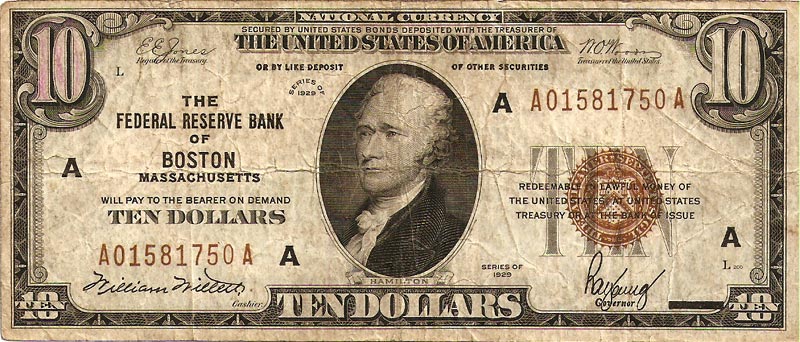
 
Series 1929 $10 National Currency Notes have a distinctive brown seal and were issued in two different varieties. The first type (which are properly called "National Currency Bank Notes") were issued by individual local banks from every state. The second type (which are more properly known as "Federal Reserve Bank Notes") were issued by all twelve Federal Reserve districts (Boston, New York, Philadelphia, Cleveland, Richmond, Atlanta, Chicago, St. Louis, Minneapolis, Kansas City, Dallas, and San Francisco).
This particular note is a Federal Reserve Bank Note issued by the Federal Reserve Bank of Boston, Massachusetts. The obverse bears the legend, "NATIONAL CURRENCY SECURED BY UNITED STATES BONDS DEPOSITED WITH THE TREASURER OF THE UNITED STATES OF AMERICA OR BY LIKE DEPOSIT OF OTHER SECURITIES" and a redemption clause that reads, "REDEEMABLE IN LAWFUL MONEY OF THE UNITED STATES, AT UNITED STATES TREASURY OR AT THE BANK OF ISSUE." The obligation clause reads, "THE FEDERAL RESERVE BANK OF BOSTON WILL PAY TO THE BEARER ON DEMAND TEN DOLLARS."
|
|
Series 1934A Ten Dollar Federal Reserve Note
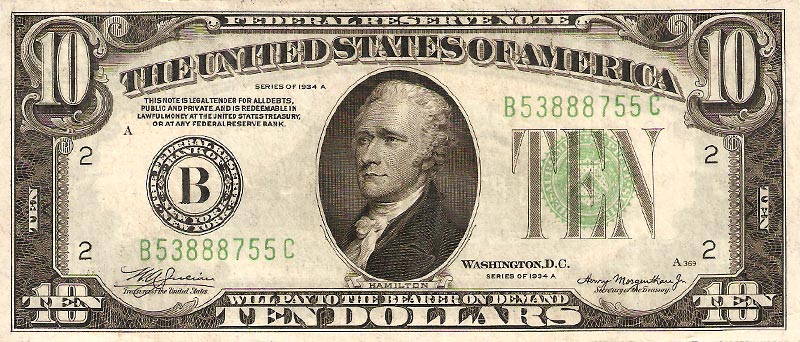
 
The Series 1934 $10 Federal Reserve Note features a green Treasury Seal on the right as well as a black seal on the left bearing the identity of the Federal Reserve Bank of issuance. The regional seal is a design facet unique to Federal Reserve Notes, because almost all other types of notes were issued directly by the U.S. Treasury. Since these were issued after the the Gold Reserve Act of 1933, the obligation clause on the obverse reads, "THIS NOTE IS LEGAL TENDER FOR ALL DEBTS, PUBLIC AND PRIVATE, AND IS REDEEMABLE IN LAWFUL MONEY AT THE UNITED STATES TREASURY, OR AT ANY FEDERAL RESERVE BANK." The redemption clause on the obverse states, "THE UNITED STATES OF AMERICA WILL PAY TO THE BEARER ON DEMAND TEN DOLLARS."
The reverse features a view of the historic U.S. Treasury building.
|
|
Series 1934 Ten Dollar Silver Certificate

 
Once redeemable for silver on demand, the Silver Act of 1963 ended traditional silver currency and most of these obsolete notes were redeemed and destroyed. The obverse of the Series 1934 $10 Silver Certificate features John Trumbull`s classic portrait of Alexander Hamilton along with the distinctive blue Treasury seals and serial numbers unique to Silver Certificates. The obligation clause reads, "THIS CERTIFIES THAT THERE IS ON DEPOSIT IN THE TREASURY OF THE UNITED STATES OF AMERICA TEN DOLLARS IN SILVER PAYABLE TO THE BEARER ON DEMAND." The redemption clause states, "THIS CERTIFICATE IS LEGAL TENDER FOR ALL DEBTS PUBLIC AND PRIVATE."
|
|
Series 1934A WWII North Africa Ten Dollar Emergency Note

 
This special 1934A $10 Silver Certificate was printed for use during Operation Torch (the British–American invasion of French North Africa in World War II during the North African Campaign, starting on 8 November 1942). Unlike the standard silver certificates that bear a distinctive blue Treasury seal, these notes have a special yellow Treasury seal to assure instant recognition (and devaluation) in the event of defeats by the enemy, or enemy capture of large quantities of cash. These are also known as "yellow seal" Silver Certificates.
|
|
Series 1934A WWII Hawaii Ten Dollar Emergency Note
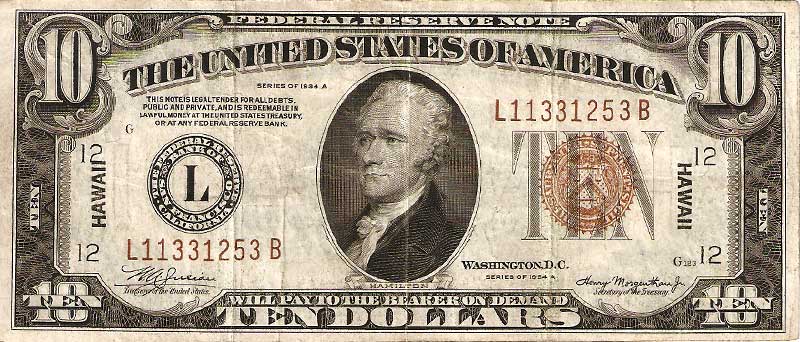
 
This special 1935A $10 Federal Reserve Note was printed for use in Hawaii after the Japanese attack on Pearl Harbor. Unlike the standard Federal Reserve Notes that bear a distinctive green Treasury seal, these notes have a special brown Treasury seal to assure instant recognition (and devaluation) in the event of defeats by the enemy, or enemy capture of large quantities of cash. In addition, the word "HAWAII" is overprinted on the obverse and reverse.
|
|
Series 1950B Ten Dollar Federal Reserve Note
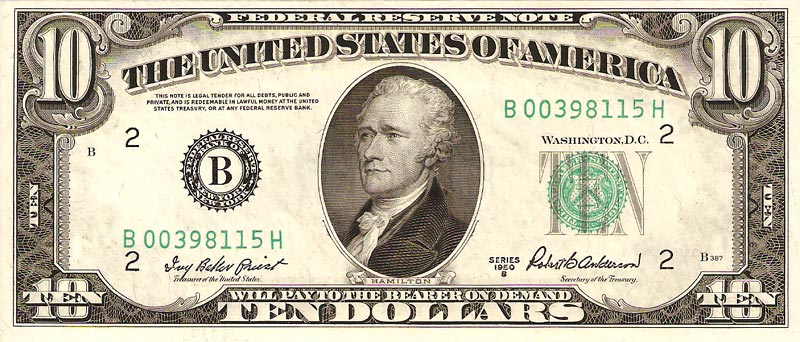
 
The Series 1950 $10 Federal Reserve Note is very similar to the 1934 version, except that the green Treasury Seal on the right is a little darker and smaller, the words "WASHINGTON, D.C." now appear above the seal instead of below it, and the font of the obligation clause has been shrunk to fit on three lines instead of four. The obligation clause reads, "THIS NOTE IS LEGAL TENDER FOR ALL DEBTS, PUBLIC AND PRIVATE, AND IS REDEEMABLE IN LAWFUL MONEY AT THE UNITED STATES TREASURY, OR AT ANY FEDERAL RESERVE BANK." The redemption clause on the obverse states, "THE UNITED STATES OF AMERICA WILL PAY TO THE BEARER ON DEMAND TEN DOLLARS."
The reverse features a view of the historic U.S. Treasury building.
|
|
Series 1953 Ten Dollar Silver Certificate

 
The design of the $10 Silver Certificate was redesigned slightly in 1953. It still featured a central portrait of Alexander Hamilton on the obverse with the U.S. Treasury building on the reverse, but the size and location of various elements on the obverse were changed.
|
|
Series 1963A Ten Dollar Federal Reserve Note

 
The Series 1963 $10 Federal Reserve Note is very similar to the 1950 version, except that obligation clause on the obverse simply reads, "THIS NOTE IS LEGAL TENDER FOR ALL DEBTS, PUBLIC AND PRIVATE" and the redemption clause has been removed completely to indicate the fact that U.S. currency was now considered fiat money, unbacked by any physical asset. Also, the words "IN GOD WE TRUST" have been added to the reverse.
|
|
One Dollar | Two Dollar | Five Dollar | Ten Dollar | Twenty Dollar | Fifty Dollar | Hundred Dollar | Miscellaneous
|
|
|